| 1926 UK & Ireland Greyhound Racing Year | |
|---|---|
 | |
The 1926 UK & Ireland Greyhound Racing Year was the inaugural year of 'track' greyhound racing in the United Kingdom and Ireland. [1]
| 1926 UK & Ireland Greyhound Racing Year | |
|---|---|
 | |
The 1926 UK & Ireland Greyhound Racing Year was the inaugural year of 'track' greyhound racing in the United Kingdom and Ireland. [1]
On the 6 March 1876, near the Welsh Harp, Hendon, an early attempt to introduce mechanical track greyhound racing took place. It was on a straight course 400 yards long, with the hare being drawn along the ground at the end of a cord, which was wound around a windlass. The venture did not appeal to the public because although the fastest greyhound would always win, the cleverest (best tracker) did not. [2] [3] [4]
In 1890, a patent was taken out for a circular greyhound racing track but was never put into practice, due to the patent owner not having financial backing. Five years later a mechanical lure was used in Ireland and again failed. [2] [3]
Thirty years later in 1925, Charles Alexander Munn, an American businessman, who had seen greyhound racing in the United States came over to the United Kingdom and teamed up with Owen P. Smith and George Sawyer for the rights to promote the British greyhound racing as an alternative to coursing which was the primary form of greyhound racing in the United Kingdom and Ireland. [5] Munn met with Major L. Lyne Dixson (a leading figure in British field sports) and the pair decided to find other supporters despite the fact that the General Strike of 1926 was looming. [6] [7] [4]
The two men eventually met Brigadier-General Alfred Critchley, who in turn introduced them to Sir William Gentle JP. Eventually they raised £22,000 and formed a company called the Greyhound Racing Association Ltd, or GRA for short. When the GRA were deciding where to situate a new stadium they thought Manchester was an ideal place because of its sporting and gambling links. The company constructed the first custom-built greyhound stadium near the city centre and called it Belle Vue Stadium, where the very first race around an oval track in Britain was held on 24 July 1926 at 7.30 pm. [2] [6] [7] [4] [1]
With over one million people unemployed and the first general strike in history taking place and troops had been deployed to trouble spots throughout Britain. Greyhound racing offered an affordable day out, away from all of the issues and as a result greyhound racing underwent remarkable growth over the next decade. [2] [6] [7] [4]
Only 1,700 people attended the first meeting at Belle Vue and they watched six races with seven dogs in each race. A greyhound called 'Mistley' won the first ever race over 440 yards, running the quarter-mile flat course in 25.00 seconds, Mistley romped home eight lengths clear at 6/1. Fifty years later a stand was named after Mistley. [2] [6] [7] [4] [8]
Belle Vue ran many races with seven runners per race but after the formation of the National Greyhound Racing Club (NGRC) in 1928, the maximum number of dogs per race was limited to six, although this rule was to change several times during the century. The colours of the racing jackets that night were - trap 1-red, 2-blue, 3-white, 4-green, 5-black, 6-orange & 7-red and white. Racing was very erratic compared to today because the greyhounds lining up were various mixes of former coursing hounds with no experience of oval racing except for a scattering of trials. Winning distances for the six races were 8, 1, 12, 10, 5 & 2 lengths. [2] [6] [7] [4]
The GRA actually lost £50 on the first night because of the small attendance but the following week the crowds turned out in force; more than 16,000 people attended the meeting and within a short space of time "going to the dogs" became a national pastime. From the first meeting in July to the day the GRA closed for the winter break just three months later on 29 October, over 11,000 racegoers (per meeting) had paid to watch each of the 37 meetings. During those meetings there had been 221 races. The consortium repaid a £10,000 bank loan and shares in the new company rose from their initial value of one shilling to £37 10s. Two Belfast bookmakers called Joe Shaw and Hugh McAlinden visited Belle Vue during 1926 with the intention of gaining ideas to start track racing in Ireland. [2] [6] [7] [4]
The greyhounds themselves were generally supplied by coursing trainers, owners and breeders such as Sidney Orton, a Norfolk farmer who sold 17 greyhounds to Belle Vue for £170. A brindle greyhound called Mutton Cutlet, whelped in March 1921, had contested the Waterloo Cup in 1923, 1924 and 1925 and finished runner up in the Waterloo Plate in 1924. In 1926, he was brought by Tom Morris, keeper of the Irish Stud book. Morris put him to stud, demanding a fee of 10 guineas. Mutton Cutlet became the first major breeding sire (male parent) in track racing.

Wimbledon Stadium, also known as Wimbledon Greyhound Stadium, was a greyhound racing track located in Wimbledon in southwest London, England.

Belle Vue Stadium was a greyhound racing track in Belle Vue, Manchester, England, where the first race around an oval track in Britain was held on 24 July 1926. It has also been used for motorcycle speedway, as the home ground of Elite League team Belle Vue Aces from 1988 until 2015, and from 1999 until 2019 for stock car racing and banger racing.

Greyhound racing is a sport in the United Kingdom. The industry uses a parimutuel betting tote system with on-course and off-course betting available. Attendances have declined in recent years, mainly due to the decrease in evening fixtures with the majority of fixtures being held in the daytime.

The Greyhound Racing Association was a UK-based private company founded in 1925 and existed until 2019. It was involved in the management of sports venues, notably greyhound racing stadia. The GRA was responsible for introducing Greyhound racing in the United Kingdom and was the largest racing operator for 70 years but diminished when trading as GRA Acquisition from 2005-2019. Despite its name, it was not involved in the administration of greyhound racing itself.
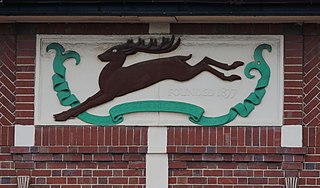
Perry Barr Stadium (also known as Perry Barr Greyhound Stadium and previously as Alexander Sports Ground(s)) is a greyhound racing and motorcycle speedway stadium on Aldridge Road in Perry Barr, Birmingham, England. The track is operated by the Arena Racing Company (ARC), who lease it from owners the National Asset Management Agency. Racing takes place every Saturday evening, in addition to their four ARC fixtures.
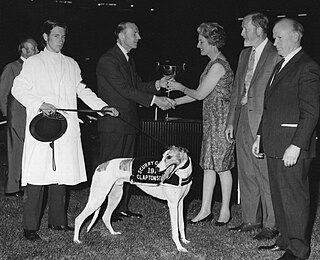
The Scurry Gold Cup is an original classic greyhound racing competition currently run at Perry Barr Stadium.

White City Greyhounds was the greyhound racing operation held at White City Stadium in London. The venue was regarded as the sport's primary track during its existence.
White City Stadium was a greyhound racing and speedway stadium in Old Trafford, Greater Manchester, England.
The 1927 UK & Ireland Greyhound Racing Year was the second year of greyhound racing in the United Kingdom and Ireland.
The 1931 UK & Ireland Greyhound Racing Year was the sixth year of greyhound racing in the United Kingdom and Ireland. The total annual attendance across the country for 1931 increased to 17,906,917 from 17,119,120, a fifth consecutive annual increase.
The 1932 UK & Ireland Greyhound Racing Year was the seventh year of greyhound racing in the United Kingdom and Ireland. The total annual attendance across the country for 1932 topped 20 Million, increasing to 20,178,260 from 17,906,917, a sixth consecutive annual increase.
The 1933 UK & Ireland Greyhound Racing Year was the eighth year of greyhound racing in the United Kingdom and Ireland.
The 1936 UK & Ireland Greyhound Racing Year was the 11th year of greyhound racing in the United Kingdom and Ireland.
The 1937 UK & Ireland Greyhound Racing Year was the 12th year of greyhound racing in the United Kingdom and Ireland.
The 1938 UK & Ireland Greyhound Racing Year was the 13th year of greyhound racing in the United Kingdom and Ireland.
The 1964 UK & Ireland Greyhound Racing Year was the 38th year of greyhound racing in the United Kingdom and Ireland.
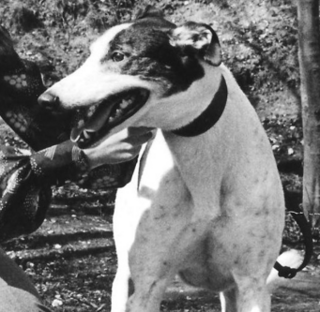
The 1970 UK & Ireland Greyhound Racing Year was the 44th year of greyhound racing in the United Kingdom and Ireland.

The 1971 UK & Ireland Greyhound Racing Year was the 45th year of greyhound racing in the United Kingdom and Ireland.
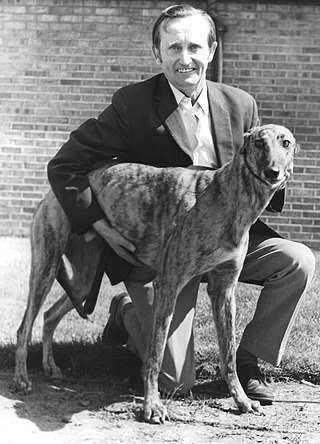
The 1972 UK & Ireland Greyhound Racing Year was the 46th year of greyhound racing in the United Kingdom and Ireland.
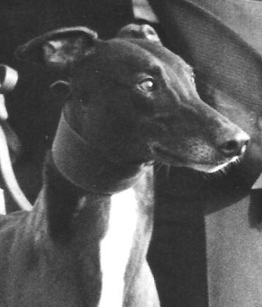
The 1982 UK & Ireland Greyhound Racing Year was the 56th year of greyhound racing in the United Kingdom and Ireland.